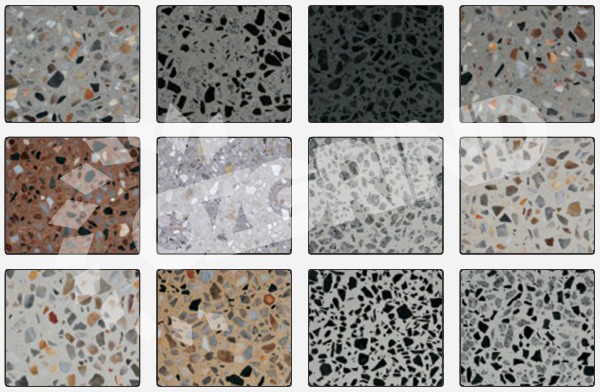Q. Can you choose the colour of the polished concrete?
A. If you want to polish the concrete of an existing slab then you are limited usually to whatever is already in the concrete. Your only real option if you don’t like the color or the cement and aggeragate is to put a colour dye over the top.
If you are pouring a new slab you can choose the colour of your cement and the colour of your stone (aggregate) there are a number of concrete suppliers you can visit. Some examples are below…
It is important not to underestimate the colour of the cement as this can significantly change the look and the cost of the floor. Below is an example of polished concrete sample using the same stone but changing the colour of the cement:
Q. How long does concrete polishing take?
A. The time it takes to polish concrete depends on a few factors – firstly of course how big the area is, and also if the space is open or if there are lots of small rooms that require hand work, then it depends on which concrete polishing procedure you want – hiperfloor or grind and seal, then how much exposure of stone you want to see, and the level of shine you want. But as an example a normal double garage for a grind and seal is usually completed in 2-3 days. And a house that has approx 100m2 of hiperfloor allow 5-6 days.
Q. What does polished concrete cost?
A. It is usually worked out on a square meter rate, and price again depends on the procedure – hiperfloor or grind and seal, level of exposure, condition of the concrete etc. It is best to ask us for a quote. Any jobs that are under 30m2 usually end up being a job rate rather than per square meter.
Q. Can I have polished concrete in wet areas? Shower bases etc?
A. Yes it is possible, but we would recommend doing a grind and seal instead of a hiperfloor. With the grind and seal the topical sealant will be water tight so no water penetrates into the concrete.
Q. Is there much mess or dust during the concrete polishing procedure?
A. When doing the main grind there is very little dust in the air as we use high grade dust extractors. There is a minimal amount of dust created when using the hand grinders if required. After each step during the procedure the floor is cleaned and on completion there is no mess or dust to be seen.
Q. How do I clean my polished concrete?
A. The best way to keep your polished concrete in good condition is to use a ph neutral cleaner followed by clean water for spills, otherwise a microfiber mop will get rid of dust.
Q. Can you do repairs to our existing polished concrete floor?
A. As a general rule yes. Hiperfloor can be repaired easily in small areas, however with a grind and seal entire areas usually need to be done to avoid any differentiating spots.
Q. If I am pouring a new concrete slab, when is the best time for the concrete to be polished?
A. It is best that we get in touch with your concreter as soon as possible. But as a general rule the concrete should be cured for 28 days before we get on and grind. Then we can do the polish all at once or in two stages. If we are to do the procedure in one stage then we come in after the frame is up and internals are water tight. Or we can do it in two stages which requires us to come in and do an initial grind and grout prior to the frame being erected, then we put on a protective coating until works have been completed up until just before the plaster, then we remove the protective coating and polish up the floor.
Q. Do you pour the slab?
A. No, we generally just do the polishing or grinding, however we do have some concreters that we work closely with and can recommend to you.
Q. Does polished concrete really save on lighting costs?
A. Yes there have been customers that have stated it has saved them over 50% on electricity bills due to the reflectiveness of the surface.
Q. Will it feel cold to walk on with bare feet?
A. Suprisingly NO. Unlike tiles that have a small thermal mass, due to the size of the slab it is a good insulator and therefore will feel much warmer than tiles to touch.
Q. What about cracks in the concrete?
A. Part of our grouting procedure can actually fill in small cracks, and if you choose a hiperfloor the procedure actually hardens the top surface by up to 10 times its natural strength. If any cracks do appear we can generally repair them. However it is concrete and you can never guarantee that it wont crack.
Q. Is polished concrete slippery?
A. Generally speaking it is no more slippery than other hard flooring surfaces. Add water to it though and like any other surface it will be slippery. That is why we recommend for outdoor use to do the grind and seal procedure. This way we can add an anti slip agent to the sealer. This anti slip we can tailor to your needs, we can add a lot or a little depending on your needs.
Q. Will my polished concrete stain if I spill something on it?
A. Generally speaking it should not. We do use a sealer on all our finishes which prevent staining. However we do recommend that spills are cleaned up quickly.
Q. How do I maintain my polished concrete?
A. Depending on what procedure you have done. Grind and seals will need to be resealed every 2-10 years depending on the quality of sealer you have selected, and if you leave it too long you will need to have the floor re-grinded and sealed again. For hiperfloors generally you can just reapply the protective sealer every 10 years.
Q. Is polished concrete environmentally friendly?
A. Yes, often polishing jobs are done on existing concrete which is made from the most common mineral on earth – limestone. Concrete can also be made from waste byproducts and newer concrete may have metal, marble chips or recycled glass which reduces the amount of waste in our environment. Concrete is a very small contributer to greenhouse gases, and will out perform timber, steel, carpet and tiles.
Q. I suffer from allergies and athsma, is polished concrete a good solution for me?
A. Yes, in fact it is one of the best solutions for you. Polished concrete floors will not support the growth of toxic mould, dirt, pollen or dust mites and therefore is perfect for any sufferers of athsma or other allergies.


